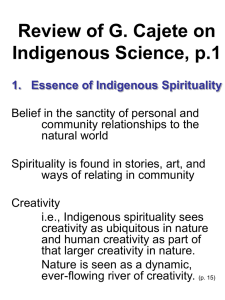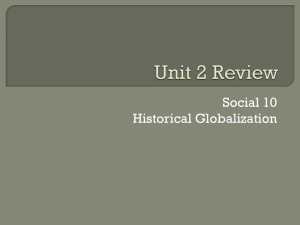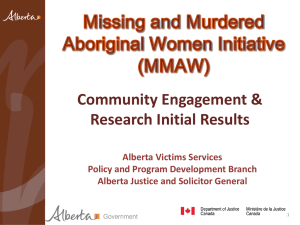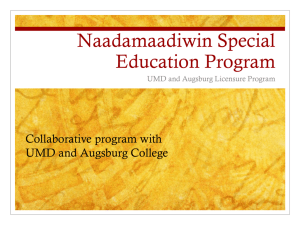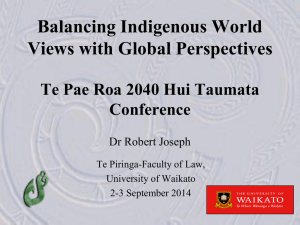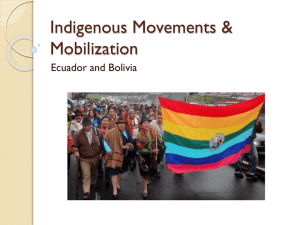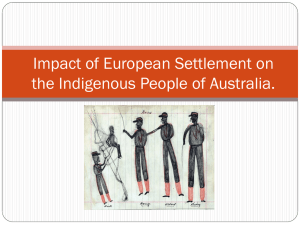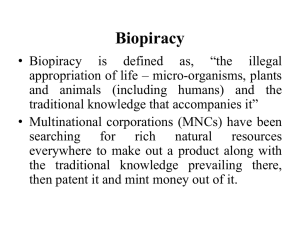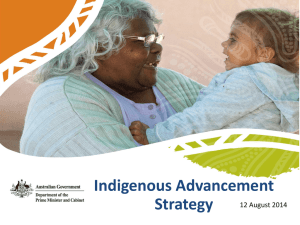Keynote Lecture slides - Minority Health Project
advertisement
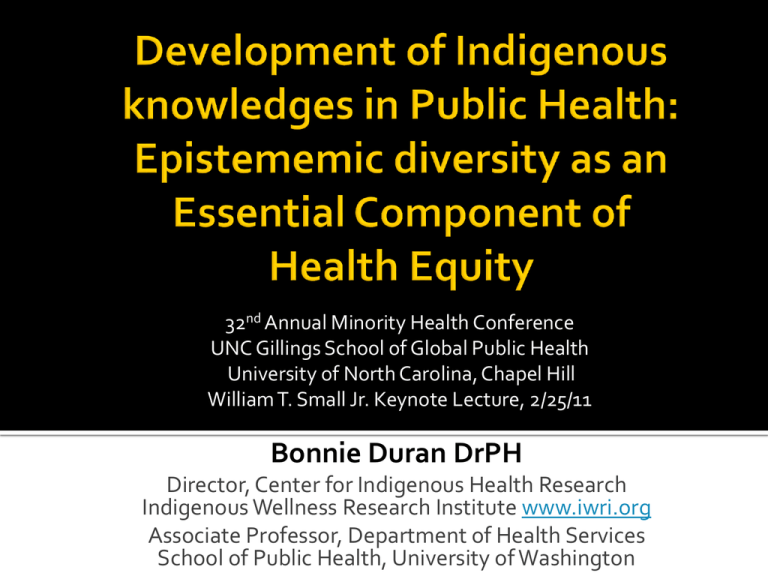
32nd Annual Minority Health Conference UNC Gillings School of Global Public Health University of North Carolina, Chapel Hill William T. Small Jr. Keynote Lecture, 2/25/11 Bonnie Duran DrPH Director, Center for Indigenous Health Research Indigenous Wellness Research Institute www.iwri.org Associate Professor, Department of Health Services School of Public Health, University of Washington Madame Chair and the MyNavajo Context Nation HRRB 4CC Project Has western knowledge production itself contributed to health inequities? Is there a power/knowledge episteme of public health that replicates colonial relationships? Can Indigenous communities, other communities of color, public health advocates and allies use partnership opportunities and research spaces for indigenous knowledge development? New western scholarship about pre-colonized America’s Define Modernity/Coloniality Episteme Examples of colonizing research Decolonizing research and practice: CBPR and the space for indigenous knowledge development In 1491 there were more people living in the Americas than in Europe. Indigenous people in the America’s transformed their land so completely that Europeans arrived in a hemisphere already massively "landscaped" by human beings. Pre-Columbian Indians in Mexico developed corn by a breeding process so sophisticated that a “Science” author described it as "man’s first, and perhaps the greatest, feat of genetic engineering." AGRICULTURE Prehistoric GM Corn Nina V. FedoroffS Science 14 November 2003: 302 (5648), 1158-1159. [DOI:10.1126/science.1092042] Tenochtitlan, the Aztec capital had a far greater in population than any contemporary European city, and unlike any capital in Europe at that time, had running water, beautiful botanical gardens, and immaculately clean streets. Alfred W. Crosby, author of Ecological Imperialism and The Columbian Exchange, Professor Emeritus of Geography, American Studies and History, University of Texas Genealogy: 17th Century No. Europe Reformation thought, Enlightenment, French Revolution crystallized in 18th Century into “Modernity/Coloniality” and consolidated within the Industrial Revolution and motivated, in part, by colonization Philosophically, emergence of the notion of “Man” as the foundation for all knowledge & order, separate from the natural and the divine Culturally, Lifeworld is subsumed by forms of expert knowledge linked to capital and state administrative apparatuses (Foucault's disciplines) Sociologically, rise of nation-state institution, knowledges for material reproduction Indigenous and Subalterns studies scholars in the America’s, India, the Atlantic, Poststructuralists, Critical theorists.. Western knowledge contains a worldview that sees human development in terms of a master narrative requiring the congruence of other cultures. Authority to determine fitness for world citizenship is based on Western knowledge that decides the criteria for what is reasonable and what is not reasonable. Globalization: all world cultures and societies are reduced to being a manifestation of European history and culture. Modern reason is emancipatory, but modernity’s “underside,” namely, the imputation of the superiority of European civilization, coupled with the assumption that Europe’s development must be followed unilaterally by every other culture ColonialityModernity • Starts in Greece and Rome • Rooted in rhetoric of salvation and progress • By necessity creates condemnatory logic, savage, primitive, marginalized Post-Coloniality Indigenous Episteme • Starts in Greece and Rome • Privileges “newness” in the archaeology/chronological history of european ideals • Subjectivities created in language and history • Starts with a critique of the limits of Eurocentric knowledge hegemony of “science” as truth: Provincialism as Universalism • Epistemic disobedience as a set of projects that focus on the common effects of the experience of colonialism • Shifts the geographies of reason • Language and concepts as only one vehicle to understand and express “reality” * From at least a “post” perspective ..defines episteme historically as the strategic apparatus which authorizes separating out from among all the statements which are possible those that will be acceptable in a field of scientificity, and which it is possible to say are true or false or “meaningless” * Michel Foucault, Power/Knowledge (1980, p.197) *My addition - borrowed from Sami Scholar Rauna Kuokkanen Colonial Research Practice: Examples of Knowledge/Power Nexus Indigenist Critique of Western Episteme’s History is written by people in power 15 Colonization - Governance of “frontier” by ‘central’ authority Main governance institutions: Geographical incursion Ideological “stories” about race & skin color Church Socio-cultural dislocation Medicine/Public Health Education/Research External political control Provision of low-level social services Business/Industry Both similar and different from larger global imperial projects Kelm, M.-E. (1998). Colonizing bodies : aboriginal health and healing in British Columbia, 1900-50. Vancouver, BC: UBC Press. Assimilation and Allotment 1870-s - early 1900s 1880’s Growth of BIA boarding schools 1883 Some Traditional Medicine Outlawed 1887 Allotment Act abolishes group title to Native land Shelton, B. L. (2004). Legal and Historical Roots of Health Care for American Indian and Alaska Native in the United States. Menlo Park & Washington DC: The Henry J. Kaiser Family Foundation. “Promiscuous sexual intercourse among the unmarried of the Apache Indians is common. They are polygamist. The women are unclean and debased. The Navajos’ , a branch of the Apache tribe, line in the rudest huts and lead a drunken worthless life. The women are debased and prostituted to the vilest purposes. Syphilitic diseases abound….” McClellan, E. (1873). Obstetric Procedures among the Aborigines of North America. Clinic of the Month, 99-106. “it seems ..a reproach upon Him...that she should be the most poorly prepared ..for the reproduction of her kind…” Parker, T. (1891). Concerning American Indian Womanhood-An Ethnological Study. American Gynecology and Pediatrics, 5, 330-341. The basket drum The drum stick The Plumed wands Kethawns Sacrificial Cigarettes Matthews, W. (1893). Some Sacred Objects of the Navajo Tribe. Archives of the International Folklore Association 1, 227-254. …the greatest, most “…determine question of whether true Indian is dying out’. precise, productive, and comprehensive system of control of human beings will be built on the smallest and most precise of bases. Hoffman, F. (1928). The Navajo Population Problem. Proceedings of the twenty-third International Congress of Americanists 23, 620-633. Hoffman, F. (1930). Are the Indians Dying Out? American Journal of Public Health, 20, 609-614. Knowledge, race and social position Interpreter, health educator, health systems navigator, medicine person… • …driver Nursing outlook, June 1961 Health research served as a “roadmap” for colonizers who utilized IHS to overcome difficulties of transportation and communication in more remote, previously inaccessible locations 24 DR is a purposeful approach to “transforming the institution of research, the deep underlying structures and taken-for-granted ways of organizing, conducting, and disseminating research knowledge” DR enables indigenous communities to theorize their own lives connecting with past and future generations Drawn from work of Smith, L.T. (2005). On Tricky Ground: Researching in the Age of Uncertainty. In Denzin & Lincoln (eds.). Handbook of Qualitative Research. Sage Publications Indigenous knowledge (IK) as ancient, communal, holistic, spiritual and systematic knowledge about every aspect of human existence Local communities through accumulated IK gained from generation to generation, knew: Social order through culture-based sanctions and rewards for appropriate behavior Longevity through Indigenous Public Health Healthy physical environments through stewardship, ETC ETC ETC “Logic of the gift” as a foundational epistemic convention grounded in valuing Gifting functions as a system of social relations, forming alliances, solidarity Gifting extends to giving and receiving in the natural and spiritual realms Reconstructing indigenous Epistemes offers alternative paradigm for everyone, not just Natives.. Rauna Kuokkanen (2007) Reshaping the University: Responsibility, Indigenous Epistemes, and the Logic of the Gift. Vancouver, University of British Columbia Press Evidence based Interventions may be a form of forced acculturation Indigenous health promotion and treatment is often effective “cultural revitalization” 28 cumulative vulnerability that colonization; i.e., epidemic disease, forced removal, warfare, and white cultural hegemony, have had on the physical manifestation of health among indigenous peoples. 29 30 • • • • • • • • • • Story telling Sweat Lodge Talking circle Vision quest Wiping of tears Drumming Smudging Traditional Healers Herbal remedies Traditional activities 31 Decolonizing research and training Partnerships with T/U/I Indigenous Knowledge reclamation and production Harness resources of UW and partners towards mission Partners – MOU with American Indian Higher Education Consortium Northwest Indian College National Congress of American Indian Policy Research Center National Indian Health Board Affiliated Tribes of Northwest Indians Center for Indigenous Health Research -- IWRI Navajo Nation NM Pueblo’s AAIHB NRG UW NWIC AIHEC 30 TCU Genealogy of Partnerships Funding NIDA, OBSSR, NCRR, IHS 34 UNM TEAM 35 UNM & UW TEAM The NCAI Policy Research Center is a tribally-driven think tank that supports Native communities in shaping their own future by gathering credible data, building tribal research capacity, providing research support, and convening forums addressing critical policy questions. As sovereign nations, tribes have a role in the research that is conducted in their communities and in regulating research which occurs on their land and with their citizens. - Joe Garcia, Former President, NCAI Established in 2003 as a national tribal policy research center that would focus solely on issues facing tribal communities Forum for forward-thinking, deliberate, proactive Indian policy discussions and the development of policy scenarios Research in service to community Direct implications for communities and improving their well-being Community-driven agenda and all aspects of the work Honor community and cultural contributions to the work Partnership with communities and other organizations Respect tribal sovereignty and ownership of data Indigenous knowledge is as valid as academic knowledge Research should build community capacity 39 Partnership between Indian Health Service & NIH 3 Goals Reduce mistrust train “Expert Indians”, pipeline program conduct rigorous health disparities research Tribal organization must be lead and maintain 30% of funds 40 1. Describe the variability of CBPR across dimensions in the model to identify differences and commonalities across partnerships 2. Describe and assess the impact of governance on CBPR processes and outcomes across AI/AN and other communities of color. 3. Examine the associations among group dynamic processes and three major CBPR outcomes: culturally-responsive and centered interventions; strengthened research infrastructure and other community capacities; and new health-enhancing policies and practices, under varying conditions and contexts. 4. Identify and disseminate best and promising practices, assessment tools, and future research needs MODELS ARE “AN IDEALIZED REPRESENTATION OF REALITY THAT HIGHLIGHTS SOME ASPECTS AND IGNORES OTHERS.”* * Pearl, J. (2000). Causality: Models, reasoning, and inference. Cambridge, England: Cambridge University Press. “MODELS OF COURSE ARE NEVER TRUE, BUT FORTUNATELY IT IS ONLY NECESSARY THAT THEY BE USEFUL”** ** Box, G. E. P. (1979). Some problems of statistics and everyday life. Journal of the American Statistical Association, 74, 1–4 43 44 369+ Federally funded active in 2010 Vulnerable population Include NARCH n = 126 Children/Youth Include PRC n = 61 Low-Income n = 14 People w/ Disability n = 27 Elderly API 15 n = 53 Rural AA 72 n = 45 Migrant / Immigrant Latino 97 n = 56 Families N= 427 Ethnicity AIAN 32 White 7 Multicultural 48 n=3 LGBTQ / MSM None of the above 107 45 NIDA 5R01DA029001-02 Funding period: 2009 – 2013 Partner: American Indian Higher Education Consortium- 31 Tribal Colleges and Universities Leo Egashira Maya Magarati Myra Parker Ramona Beltran Elana Mainer 1. Establish partnership and board (CBPR) 2. Compile and summarize literature 3. Key Stakeholders survey-needs and capacity 4. Qualitative review of culture-centered and evidence based interventions 5. Develop effective outreach and screening procedures In the Practice World Adapted from: The California Endowment Rodney Hopson, Ph.D. 1. The social location of the student/researcher matters (intersectionality) Gender Race Class Ethnicity Education Privilege/target Sexual orientation Etc… What else? Hankivsky, O., & Cormier, R. (2009). Intersectionality: Moving Women’s Health Research and Policy Forward. Vancouver: Women’s Health Research Network. This publication is also available online at www.whrn.ca. 51 2. Research plays a role in furthering social change and social justice Ability and duty to recognize asymmetric power relations and to challenge systems and mechanisms of inequity and injustice in hope of dismantling oppression Theoretical approaches: Indigenist, Queer, critical, feminist, cultural humility, anti-racist, postcolonial, etc… What else? 52 3. Avoiding ethnocentrism means embracing multiple cultural perspectives shift between diverse perspectives Recognizes ethnocentric standards and ideas HOW? Employ a team who can “translate” research from multiple cultural contexts 53 4 Culture is central to the research process worldview, values and norms impact the uses of, reactions to, and legitimacy of, any research multicultural validity - defining social problems norms will play out in the context of research instruments and protocols. 54 5 Culturally and ethnically diverse communities have contributions to make in redefining the research field standards, guidelines, methods and paradigms of the research field need to be rethought, and underserved and marginalized culturally diverse groups have an important role to play in this process 55 The role of the intellectual, according to Delueze, is not to awake consciousness but to weaken the power of hegemonic discourse and to create the space for competing discourses to be formulated and dispersed. From this position, then…if you make it your task not only to learn what’s going on there through language, through specific programs of study…through historical critique of your position as the investigating person. When you take the position of not doing your homework, I will not criticize because of the accident of my birth, the historical accident, that is a pernicious position. Gayatri Spivak. Postcolonial critic Quote from Navajo Nation IRB Chair, Ms. Beverly Pigman (June 27, 2006) May all beings be happy. 58
